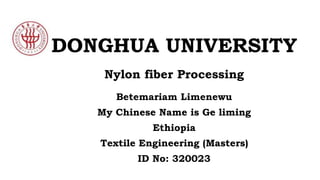
Manufacturing Processes of Nylon 6 & 6,6 Fibers
- 1. DONGHUA UNIVERSITY Betemariam Limenewu My Chinese Name is Ge liming Ethiopia Textile Engineering (Masters) ID No: 320023 Nylon fiber Processing
- 2. Outline of presentation • Introduction • Difference between nylon 6 & 6,6 • Manufacturing process of Nylon 6 & 6, 6 fiber • Properties of Nylon fiber • Application of Nylon fiber
- 3. Introduction Nylon is the most useful synthetic material with applications varying from daily life activities to industries. The term nylon points towards a polymer family known as linear polyamides. There are two approaches to making nylon for fibre applications. In the first approach, the molecules that consist of an acidic group (COOH) on every end react with molecules that contain amino (NH2) groups at each end.
- 4. Conti… Nylon is made by a process called polymerization (condensation polymerization reaction), in which individual short molecules form long-chain macromolecules with high relative molecular mass. In the process of making Nylon fibers giant chain like polymers form amide groups which then go on to form strong hydrogen bonds. These hydrogen bonds hold the adjacent chains together and the resultant fiber is an exceptionally strong Nylon fiber.
- 5. Difference between Nylon 6 & 6, 6 i. Nylon 6 Nylon 6 is made by heating Caprolactam to about 250 oC with about 5- 10% water thrown in. Nylon 6 is only made from one kind of monomer, a monomer called caprolactam. Nylon 6,6 is made from two monomers, adipoyl chloride and hexamethylene diamine.
- 6. ii. Nylon 6, 6 Nylon 6, 6 is a linear condensation polymer made from hexamethylene diamine and adipic acid. Specific amounts of the two chemicals are combined in solution to form nylon salt. This salt is purified, polymerized, extruded in ribbon form, and chipped into small flakes or pellets. These flakes or pellets are melted and extruded through a spinneret into cool air and the nylon filaments are formed.
- 7. Conti.. • Nylon 6,6, polyamide Condensation product of aliphatic diamine with aliphatic diacid. Polymer 3D model of Nylon6,6
- 8. Conti. • Nylon 6 structure is derived from one monomer, which is a molecule that can be bonded to other identical molecules to form polymers. The nylon 6 monomer has six carbon atoms, hence the name nylon 6. • Nylon 6/6 structure is made from two monomers. Each of these monomers has six carbon atoms, which is reflected in the name nylon 6/6.
- 9. Nylon fiber Manufacturing Process Adipic acid, hexamethylene diamine, and water are added to a reaction vessel to form Hexamethylene Diammonium Adipate, common known as “Nylon salt” solution. After evaporation, water continues to be removed from the “salt solution”. The nylon polymer is then extruded through spinnerets or pelletized. A slurry of TIO2 pigments and water, used to deluster fibers, is added to the Nylon salt. Polymerization begins in the reactor where polyhexamethylene adipamide, (Nylon 66), is formed. The Nylon polymer is then extruded through spinnerets or pelletized.
- 10. Conti.. Nylon fiber manufacturing process
- 11. Spinning process of Nylon fiber The spinning of nylon 6 is done by using the “melt spinning” process. In this process, the polymer gets melted under exclusion of air at a temperature of 250 °C- 270 °C ( 30 °C-50 °C more than the melting point ). For a very homogenous melting process, the polymer is melted in an extruder. The hot and molten polymer is fed to the spinnerets with the help of a feeding pump and extruder. This molten polymer passes through very small holes of spinnerets. “Thus the nylon 6 filament is formed”. On the lower part of the spinneret, the filaments are entered the quench duct. This is a part of 2-4 metres where the still hot filaments are quenched with air. It is very important to keep the airflow very gentle and stable to avoid the filaments sticking together.
- 12. Manufacturing nylon fibers and nylon yarns, as explained in the following: • Polycondensation This is a chemical process to produce the nylon polymer using caprolactum and acetic acid. • Chipping The nylon rope produced from the polymerization process is cut into chips.
- 13. Conti.. • Melting In this stage nylon chips are melted to reach the viscosity suitable for pumping to the spinning process. • Spinning In this process, molten nylon is pumped to spinnerettes, and the polymer streams coming out are cooled by blown air that let the polymer solidifies and form continuous nylon filament.
- 14. Properties of Nylon fiber • Shape: Shape is controlled by the manufacturer, filaments are uniform and long. • Luster: Bright to Dull • Elastic Recovery: 100% • Elongation: Good • Resiliency: Good • Density: 1.1 g / ccm • Moisture absorption: 8%
- 15. Conti… • Dimensional stability: Excellent • Acids: resistance is poor • Alkalies: Good resistance • Sun light: Generally affects • Insects: Normally damages • To flame: Self extinguishing
- 16. Application of Nylon Fiber